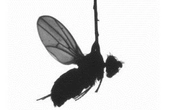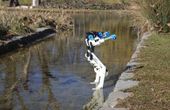Single Actuator Wave-Like Robot
A robot which can move forward or backward by producing a continuously advancing wave. The robot has a unique minimalistic mechanical design and produces an advancing sine wave, with a large amplitude, using only a single motor but with no internal straight spine.
Technical Specifications
| Length helix | 25 |
| External diameter | 5.2 |
| Radius | 2.1 |
| Manufacturing technology | |
| Power | 6 |
| Motor | 12 |
| Torque | 2.9 |
| Weight | 188 |
Overview
The direction is determined by the direction of the rotation of the motor. The robot is made of four main parts:
- the motor house
- the motor
- the helix
- the series of links.
The motor is attached to the motor housing from one side and to the helix from the other side. The links are connected to the motor house. When the motor rotates the helix, the links cancel the rotation along the axis of the helix and maintain the vertical motion. In this way, the links act as a 2D projection of the helix of the robot.
The helix is nearly 25 cm long and is made of two windings and a short extension to reduce its diameter. Its external diameter is 5.2 cm and its radius is A = 2.1 cm. The links, presented are 7 cm wide 1.83 cm high, and the distance between the joints of two links is 1.2 cm.
The helix and the links are 3D printed. The robot is fitted with a 6 Volt, 12 mm motor with 300:1 gear ratio.
References
Describes the kinematics of the wave locomotion. Presents a design for the wave-like robot and model its kinematics. The kinematical model was used to optimize the design of the robot. Finally, experiments are performed with the robots which are built.






















